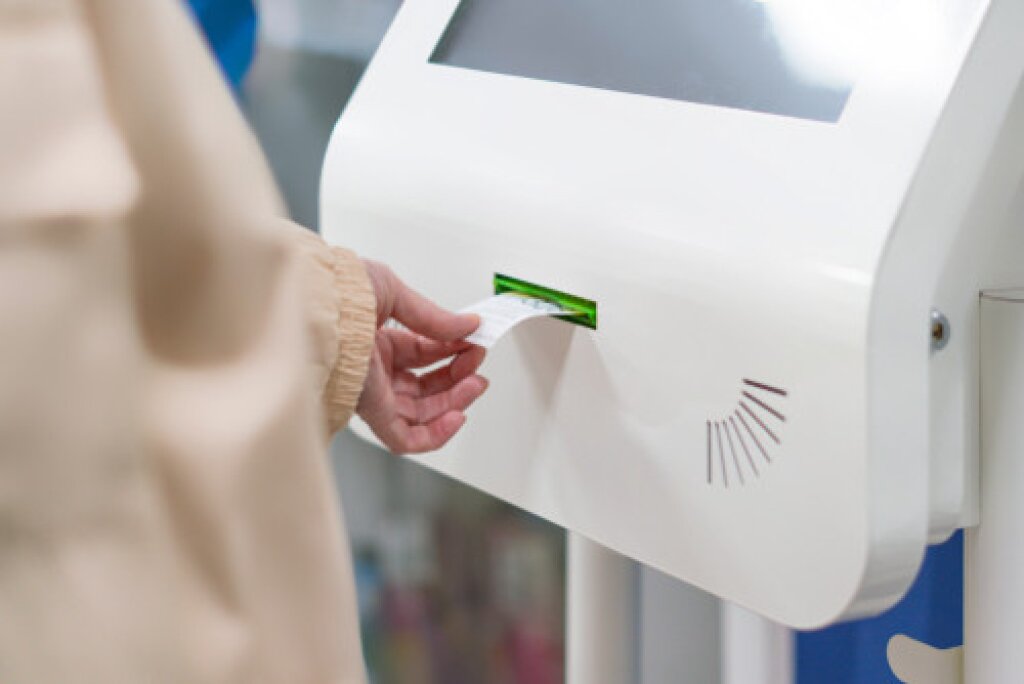A complete guide to queue management systems
This guide provides an overview of the principles of queueing, the components of a queue management solution and the advantages of generating positive wait-time experiences.
Are you looking for a queue management system for your business?
Contact us now to find out more about our Smart Queue software.

Queue management is a modern business necessity
Queue-times affect people. People have low tolerance levels for long or slow-moving queues and evidence indicates that they are likely to abandon the activity they are waiting for, and/or to complain bitterly about the inconvenience.
Queue sensitivity is most closely monitored in the retail sector. In retail, queue management is essential as long queues have a direct impact on transaction levels. Shoppers are more likely to abandon their purchases as they have many alternatives such as online outlets and competing bricks and mortar stores.
However, while queues in the retail sector are the most analysed, long and slow-moving queues, and long wait-times, adversely affect a wide variety of venues and facilities. Medical practices, transport hubs, tourist venues, hotels and leisure facilities are all susceptible to waiting-time and queuing issues that have a range of consequences.
Positive queuing experiences influence customer behaviour
Sometimes queue management is about operational efficiency, and often it is about sales effectiveness.
Have you ever tired of waiting for an elevator or of standing in line at a bank? Have you ever abandoned your shopping basket in frustration and left a store without buying?
Bricks and mortar retail, in particular, faces challenges as more transactions migrate online. Organisations of all kinds have to work out how to deliver great customer experience without it costing a fortune.
In this article, while we look at the psychology of queuing, queue management systems deployed in a variety of locations, and first consider the advantages of AI-driven queue management that can be installed on CCTV camera systems in high footfall locations.
What is a queue management system?
A queue management system is a tool designed to streamline and manage customer flow in service environments.
Queue management helps to reduce wait times by organising and prioritising queues, whether virtual or physical.
Systems can assign tickets, display wait times and notify customers when it is their turn.
Alternatively, operators can take control of queues by receiving CCTV-generated alerts when queues become too long.
By improving efficiency and customer experience, queue management reduces congestion, enhances service delivery and provides valuable insights into customer patterns and staff performance.
The case for queue management over CCTV
Facit specialises in delivering detailed analytics captured on CCTV cameras, including people counting, heat mapping and queue management.
Queue management via CCTV is unlikely to be suitable as a replacement for ticketing systems and virtual queue management (apps) in niche environments such as doctors’ surgeries and restaurants.
However, CCTV queue management is ideal for deployment in busy environments such as supermarkets, pharmacies, transport hubs, museums and other tourist venues.
Facit provides CCTV queue management as it offers unique advantages over alternative systems such as sensors and beam counters. The big plusses include:
Works on already-installed CCTV cameras
No additional hardware or cabling required
Installed in less than an hour without disrupting operations
Integrates with installed management systems
Provides immediate alerts based on wait-time thresholds
Provides accurate real-time and historical data
Guaranteed future-proofing to scale and evolve with systems
Warranted product roadmap with AI functionality
In summary, queue management over CCTV is the simplest to deploy, the most flexible, the most future-proof and the most cost-effective queue management system.
Benefits of a queue management system
A queue management system generates numerous benefits, including reduced wait times, which enhances customer satisfaction.
Systems optimise service efficiency by streamlining the flow of customers, which improves staff productivity.
Real-time data and analytics provide insights for improving operations and resource allocation.
Additionally, queue management systems minimise overcrowding and ensure a more organised environment.
By offering features like virtual queues or automated notifications, systems also improve customer convenience and overall experience, which makes the service process smoother.
How does CCTV queue management work?
CCTV queue management is extremely accurate and 100% compliant with privacy regulations.
CCTV queue management does not capture personal data. The queue management system identifies humans, bodies and heads and anonymises the resulting data.
Tags can be assigned to enable sophisticated AI functions and algorithms to track movements in waiting areas and queues, and to capture metadata including time in queue, entry/start times and departure/exit times.
In multi-camera environments, people can be handed-off from one camera view to another in order to track people’s routes continuously and their associated waiting times in multiple locations.
The positive outcomes of real-time wait-time monitoring are that instant alerts enable operators to intervene to ease congestion and accelerate queues, or to close queues when traffic is low.
Ready reports on historical activity enable operators to analyse trends and customer behaviour in order to improve operations and optimise staff resourcing to correspond with footfall and customer expectations.
How is CCTV queue management installed?
CCTV queue management installation is far simpler than for other queue management systems, for example beam counters.
There is no need for physical changes in the operator’s environment, no physical works, cabling or hardware additions.
Even pre-install surveys are straightforward; there is rarely a need for an in-person site visit.
Camera locations and camera fields of view can be surveyed and assessed remotely. In 95% of cases there is no need to adjust cameras.
A feasibility survey can be completed quickly and subsequent installation takes less than an hour, to enable queue management across any operator’s site.
When CCTV is being installed for the first time, or when legacy systems are under review, Facit works with Security, IT and Facility managers to optimise camera positioning in order to generate the best security outcomes and the most valuable business intelligence results.
Why is Facit Queue Management a superior product?
We have already pointed out the advantages that CCTV queue management offers in terms of ease of installation and cost of installation.
In addition, Facit’s queue management system provides:
Maximum ease of use
Simple user interface
Accurate wait time measurements
Programmable, variable threshold alerts
Multi-channel alerts
Installers value the fact that no additional security checks are required:
No additional safety checks required
No additional cybersecurity checks required
Systems integration is key to optimising data:
Integration with third party systems
Built-in reports captured in business intelligence suites
Integration with building and facilities management systems
Key benefits of CCTV queue management systems
Our customers report:
Significant reduction in wait times
Improved ability to manage staff resources
Decrease in queue and sales abandonment
Improved customer satisfaction
The psychology of queuing
Queue management systems are installed to ensure smooth operations, which means that it is essential to understand people’s attitude to waiting and to manage their expectations.
People waiting to be provided with a service have conscious and unconscious needs to know that progress is being made, that an outcome is imminent, and that the service provider is aware of their position.
The first principle of queue management: perception and actual waiting-times
Sometimes people feel that they are waiting for a longer time or less time than they actually are. People may be in a hurry, or they may be anxious for other reasons, or they may be bored, any of which can have an affect on how they feel about waiting in a queue.
The aim of queue management is to minimise customer wait times, which means not only the amount of time they actually wait, but also the amount of time that customers or visitors feel like they are waiting. Perceived wait time can have more of an impact on people waiting in queues than the actual wait time.
When a queue is long, people generally assume they will have a long wait, even if the line of people is moving quickly. When a venue’s lobby or waiting area is crowded or disorganised, it has a similar negative effect on people’s views.
It is possible to mitigate the stresses and irritations of queuing by implementing ‘distractions.’ For example:
You may have noticed that hotels often install mirrors by lifts and in lobby areas, as people’s own reflections or glimpses of surrounding activity provide a form of entertainment
Some car dealerships install viewing windows for customers to watch cars move through the service process
Digital media is commonly used in waiting areas or behind bank tellers, to entertain or educate, or to entice customers into using products and services
The second principle of queue management: feeling ‘in process’
It is important to let customers know that they are in the right place and that they are making progress. The sooner customers feel certain that they are part of a process the better. Once customers feel ‘in process’ the wait-time generally feels shorter.
An ‘in-process’ feeling can be generated by an acknowledgement from a staff member, an indication of likely wait-time, or a visible or audible queue-place indicator.
Savvy restaurants hand out menus to diners as early as possible to demonstrate that their presence has been noticed and that the service process has started.
Theme parks and cinemas build excitement and provide distractions in the queue, which gives customers a sense of progress and the feeling that the entertainment has begun.
The third principle of queue management: obvious best efforts
Waiting can be frustrating, but becomes even more frustrating when it seems that there are staff available and they are not helping. Customers become irritated and sometimes angry.
More shops publish ‘zero abuse tolerance’ policies prominently, and more body-worn cameras are being deployed, to counter the increasing problem of customer aggression.
Customer perception, and loyalty, improve when they feel organisations understand and are trying to do something about wait-time inconvenience.
Customers like to see a business and its staff responding to a problem and intervening to stop things getting worse. Positive intervention does not have to be demanding on staff time or expensive, and generally only needs to be deployed at peak times.
Not intervening to reduce wait-times can have serious consequences, including loud customer complaints and, ultimately, reputational damage, lost business and lost revenue.

A wide variety of queue management systems
The term ‘queue management’ is, on the face of it, self-explanatory. However, the reason why a queue forms should be kept in mind.
For a queue to form, it means that the demand for an activity exceeds the ability to supply whatever is being queued for quickly. As demand continues to grow, queues become longer.
Queue management is the attempt to reduce wait-times in different ways. Streamlining the queueing process generates a better customer experience, and there are many benefits for staff and the business.
There are many different types of queue management solutions available, which are beneficial in different types of setting:
Receptionists provide basic queue and direction management, but rely heavily on the receptionist’s skills and bandwidth
Physical barriers are easy to implement but can be stressful for customers
Ticket-based systems provide customers with information but generally lack personalisation
Digital queue management facilitates customer self-service but may alienate those who are not tech-equipped or tech-savvy
Physical queue management tends to be far less effective than digital queue management systems. In retail and other high-footfall venues, a hybrid solution can often provide the best results. By combining assets from digital and electronic components, such as CCTV data, with physical elements, such as check-in routes and payment check-outs, operators can respond to growing queues and manage peak times better.
Facilities that make use of CCTV data to manage queues are also able to generate business intelligence reports to help them track trends and manage resources. Typical reports cover:
Building occupancy
Peak business times
Average customer wait-times
Employee performance
Business intelligence reports help businesses to understand visitor trends and improve queue management.
Implementing the right queue management system
The right queue management system enables businesses to manage customer flow and wait times, and to create new queues and assign tasks to staff.
Queue management systems generally comprise a physical queue (or line) of people waiting for a service, an interface with which customers can interact, such as a check-in kiosk, or a mobile app or website, together with a back-end system to track customer data. For success, system integration and ease-of-use are essential.
From simple to sophisticated queue management systems
A receptionist who captures information and directs people to a location or waiting area is one of the simplest queue management systems. It is also one that can become over-run at peak times.
A simple ticket queue management system improves on the receptionist model, and it provides users with a clear indication of their place in a queue or line. Ticket systems are simple to implement and require minimal set-up and little training. However, ticket solutions cannot track wait times and queue lengths, and are more of a tactical deployment than a strategic business option.
Check-in kiosk systems offer an upgrade on take-a-number systems. Visitors can self-serve to check-in and get information, which can lead to faster service times. Kiosks are common and function well in high-footfall locations, or in locations that require privacy, such as doctors’ surgeries and other medical sites.
Virtual queueing software is among the more advanced queue management options available. Virtual queueing solutions are accessible from devices with an internet connection, which make them convenient for customers and staff. Virtual solutions can provide a range of service analytics such as real-time data on queue lengths and wait times. Giving customers the freedom to choose how they communicate with your business enriches their experience, increases customer flow, and reduces actual wait time.
CCTV queue management systems provide the ideal way to manage queues and generate business insights in locations where cameras are already installed. Plug-in software enables operators to capture data on building occupancy and queue lengths in order to monitor health and safety issues, as well as to respond quickly if queue lengths or waiting times exceed pre-set thresholds. Retailers are taking advantage of CCTV camera data to gather real-time information on customer flow in order to prevent purchase abandonment and create positive customer experiences.
The many benefits of a queue management system
Queue management benefits everyone in the business: managers, administrators, business analysts and the marketing team.
Queue system benefits for managers
A queueing system helps managers to:
Manage crowd traffic flow
Control entrance and exit footfall rates
Reduce pinch points at tills and check outs
Improve working environments
Evaluate customer behaviour
Queue system administrator benefits
A queuing system proves valuable to administrators by:
Tracking employee performance
Enabling better resource planning
Measuring the effectiveness of operational changes
Improving business with smart technology
Queue management generates business intelligence
The data generated by queue management system reports enables system users to compile intelligence to make informed decisions about service delivery.
Learn about visitor behaviour, expectations and needs
Manage queues effectively
Distribute work efficiently among employee
Track performance periodically, seasonally and over time
Modify service delivery to customer profiles
Balance supply and demand
Customer experience is core to satisfaction and retention
For any organisation serving a lot of people, customer experience is everything, be it in a theme park, supermarket or healthcare practice. When people see long queues or an overcrowded lobby or waiting area, and detect the frustration of other customers, it has adverse effects any business. The consequences of bad queue management include:
Lost revenue when customers abandon queues or defect completely
Staff distress and disengagement.
Reputational damage owing to bad word-of-mouth, press or online publicity
In contrast, when customers are happy about the time that they spend queueing or waiting, the results are:
Improved customer satisfaction: Better customer experience increases loyalty and creates positive word-of-mouth advertising.
Better business intelligence: Real-time data provides information to make quick, effective decisions.
Increased staff morale: Improved productivity and staff retention.
Enhanced health and safety: Less crowding and smooth traffic flow.
Better resource allocation: Ability to deploy the optimum number of staff in the right places, at the right times.
In short, effective queue management means better service provision for any type of operation, and greater profitability for commercial businesses.
Maximise use of your current infrastructure to manage queues before adding additional hardware and software
Retail stores have different queue management needs than healthcare facilities, leisure venues, government offices and transport hubs. When selecting your queue management solution provider, check that they have experience in your industry sector.
Facit has a wealth of experience working in government locations, public spaces, transport, museums and healthcare, among others. Facit installed its first queue management systems in large retailers and supermarkets around Europe, and now operates around the world.
Facit works closely with customers to help them take advantage of CCTV camera data to gather real-time information on customer flow, in order to prevent purchase abandonment, generate positive customer experiences and maintain the highest health and safety standards.
Facit’s queue management systems are quick and simple to install, and installation does not disrupt regular business. The costs of installing queue management and integration with your current business systems are low. Before contemplating buying additional hardware and software – which carry additional maintenance costs – consider how you can maximise your current assets and investments.
Slow-moving queues: purchase abandonment statistics
Fast-moving queues are an essential part of a customer’s experience. Consumers regard queue management as something that businesses should pay attention to.
The consequences of long or slow-moving queues make stark reading. Interesting statistics were published in 2023 that summarise behaviour and attitudes towards queuing in countries around the world.
The conclusion is that operators risk losing revenue and customer loyalty when they do not manage queues efficiently.
A quarter of people (25%) say they would wait a maximum of two minutes to make a purchase. 59% would wait no longer than four minutes, while 73% say they would abandon their purchase if they had to queue for more than five minutes.
Long waiting times mean that operators risk losing consumers during the final stage of transaction.
In the UK, 86% of consumers say they avoid stores if they perceive the queue to be too long, while 66% have abandoned their purchase because of long queues, with only 22% returning later to make the purchase.
The act of queuing has ripple effects that indicate the levels of frustration and irritability caused just by waiting in line. 19% of shoppers have had an argument with a partner or friend in a queue.
Retailers lose 10% of footfall owing to queues and long or unpredictable waiting times in store.
While retail analytics generate the most comprehensive statistics about queueing, other sectors provide meaningful insights. For example, 30% of patients experiencing long wait times leave before seeing the doctor, and 20% change their healthcare providers altogether. While in the dining sector, it is estimated that, without diner waiting times, the total revenue generated by a restaurant would increase by nearly 15%.
Queue management is essential in commercial operations
Effective queue management makes a measurable difference in any customer-facing environment.
Retail and leisure, for example, are highly competitive sectors and consumers have many options if their expectations are not met. Customer retention is vital as it costs five times more to acquire a new customer than it does to retain an existing one. Memorable queuing experiences are a retail imperative.
Manual queue management is resource-heavy, inconsistent and expensive. Herding and re-directing customers, opening and closing lines or check-outs, are not efficient uses of staff time.
Intelligent queue management systems enable operators to understand customer flow and actionable data enables them to manage events quickly and positively.
Facit’s Smart Queue optimises CCTV data
Facit’s queue management software, Smart Queue, enables operators around the world to take full control of queues. Operators are able to put rules in place to open routes and check-outs, and move queues when abandonment risk thresholds are reached, by acting on real-time data captured on their installed CCTV cameras.
Smart Queue means that operators can optimise staff and resources – and better serve customers – according to proven metrics, rather than relying on a member of staff’s guess work.
Smart Queue works across multiple cameras in a GDPR-compliant manner to calculate waiting times to the second. When a threshold is reached, an alert is sent via text or email, or to the operator’s VMS, or directly to a manager’s headset. Armed with real-time data, staff can make informed decisions, allocate staff to pinch-points – or even close non-productive areas – and directly influence sales.
Operators can work within known consumer tolerance levels to classify when a store is ‘busy’ and is likely to become ‘too busy,’ which directly translates into improved customer loyalty and profitability.
Are you looking for a Queue Management system?
Contact us to find out more about our Smart Queue video analytics software.




